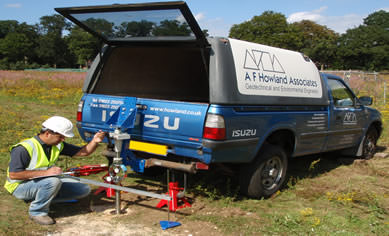|
|
|
California Bearing Ratio (CBR) Test
 This test provides a determination of the California Bearing Ratio (CBR) of a soil and can be carried out in-situ or in the laboratory. A cylindrical plunger is used to penetrate the soil at a given rate and the relationship between the force and penetration is used to calculate a CBR value. The test is only appropriate to material having a particle size not exceeding 20mm. The test is carried out off the back of a 4WD vehicle or excavator at the ground surface or in pits up to around 1.0m in depth. The test area is levelled and any unrepresentative material is removed. Sufficient surcharge discs are then placed around the test area and plunger to correspond with the overburden pressure for the test. The test is carried out by forcing the plunger to penetrate the soil over a given time. The results of penetration are used to provide a CBR value for the soil horizon. Alternatively CBR values can be estimated using hand held DCP apparatus. This test provides a determination of the California Bearing Ratio (CBR) of a soil and can be carried out in-situ or in the laboratory. A cylindrical plunger is used to penetrate the soil at a given rate and the relationship between the force and penetration is used to calculate a CBR value. The test is only appropriate to material having a particle size not exceeding 20mm. The test is carried out off the back of a 4WD vehicle or excavator at the ground surface or in pits up to around 1.0m in depth. The test area is levelled and any unrepresentative material is removed. Sufficient surcharge discs are then placed around the test area and plunger to correspond with the overburden pressure for the test. The test is carried out by forcing the plunger to penetrate the soil over a given time. The results of penetration are used to provide a CBR value for the soil horizon. Alternatively CBR values can be estimated using hand held DCP apparatus.
Example CBR Log
Dynamic Cone Penetrometer (DCP) Test
 Summary Summary
The DCP test is carried out using hand held equipment that utilises an 8 kg hammer dropped through a distance of 575 mm. This hammers a cone with an angle of 60º and maximum diameter of 20 mm into the ground. The instrument is held vertical and the hammer raised to the specified height and left to drop freely. Readings are taken of the distance of penetration (mm) into the ground for each blow of the hammer. After completing the test the DCP is removed by tapping the hammer upwards against the handle.
Following completion of the DCP tests the soils are excavated to the depth limit of the test and the sequence of deposits described. Representative disturbed samples should be taken to allow for laboratory testing if required.
The DCP test can be used to provide an assessment of the CBR value of in-situ materials, this value can then be used by others to design roads and pavements.
Example DCP Log
|
|
Call 01603 250754 or click here to send an enquiry by email
|

 This test provides a determination of the California Bearing Ratio (CBR) of a soil and can be carried out in-situ or in the laboratory. A cylindrical plunger is used to penetrate the soil at a given rate and the relationship between the force and penetration is used to calculate a CBR value. The test is only appropriate to material having a particle size not exceeding 20mm. The test is carried out off the back of a 4WD vehicle or excavator at the ground surface or in pits up to around 1.0m in depth. The test area is levelled and any unrepresentative material is removed. Sufficient surcharge discs are then placed around the test area and plunger to correspond with the overburden pressure for the test. The test is carried out by forcing the plunger to penetrate the soil over a given time. The results of penetration are used to provide a CBR value for the soil horizon. Alternatively CBR values can be estimated using hand held DCP apparatus.
This test provides a determination of the California Bearing Ratio (CBR) of a soil and can be carried out in-situ or in the laboratory. A cylindrical plunger is used to penetrate the soil at a given rate and the relationship between the force and penetration is used to calculate a CBR value. The test is only appropriate to material having a particle size not exceeding 20mm. The test is carried out off the back of a 4WD vehicle or excavator at the ground surface or in pits up to around 1.0m in depth. The test area is levelled and any unrepresentative material is removed. Sufficient surcharge discs are then placed around the test area and plunger to correspond with the overburden pressure for the test. The test is carried out by forcing the plunger to penetrate the soil over a given time. The results of penetration are used to provide a CBR value for the soil horizon. Alternatively CBR values can be estimated using hand held DCP apparatus. Summary
Summary